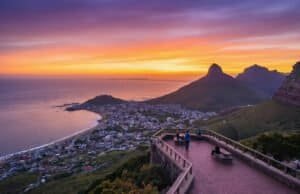South Africa is a land of breathtaking landscapes, vibrant cultures, and untamed wilderness. Still, its most famous sites, like Table Mountain or Kruger National Park, are often packed with tourists. Travelers seeking authentic experiences will find joy in South Africa’s hidden attractions. These places are free from crowds. They offer a chance to discover secret beaches, pristine wildlife reserves, cultural treasures, and urban gems.
Editors View
I’ve explored beyond guidebooks for years. After my explorations, I’ve curated 15 hidden tourist attractions in South Africa. These attractions will redefine your 2025 adventure. From untouched coastlines to ancient ruins, these off-the-beaten-path destinations promise unforgettable memories.
Table of Contents
Unexplored Coastal Gems

What are these?
Hidden treasures in South Africa are lesser-known attractions, artifacts, and cultural experiences. These secret beaches, ancient ruins, and authentic traditions offer unique, crowd-free adventures off the typical tourist path.
1. The Wild Coast’s Secret Beaches
The Wild Coast, stretching between Port Edward and East London. It is a rugged paradise hiding some of South Africa’s most pristine beaches. At Mkambati Nature Reserve, a rare waterfall plunges directly onto golden sand, creating a surreal scene few tourists witness.
The beach’s isolation ensures tranquility, with only the sound of crashing waves and calling seagulls. Mdumbi Beach, near Coffee Bay, is a surfer’s dream with perfect waves and vibrant sunrises. This is what paints the sky in hues of orange and pink.
Locals cherish it, but it remains one of the hidden tourist attractions in South Africa, far from crowded resorts. For solitude, hike 20 minutes north from Hole in the Wall Beach. Its iconic rock formation draws some attention. Nevertheless, the surrounding shores are deserted, offering private stretches of coastline. These secret beaches embody the untouched beauty of off-the-beaten-path South Africa.
2. Kosi Bay’s Ancient Fish Kraals
Kosi Bay, near the Mozambique border, is a network of crystal-clear lakes. Here, the Thonga people’s 700-year-old fish kraals stand. They are a living testament to tradition. These wooden traps, set against turquoise waters, are both a cultural and visual treasure. Snorkel the estuary to discover vibrant fish species or kayak the third lake in solitude. This hidden treasure in South Africa blends history and nature in a way few destinations can match.
3. De Hoop Nature Reserve’s Whale-Watching Haven
Less famous than Hermanus, De Hoop Nature Reserve on the Western Cape coast is a hidden treasure for whale watchers. From June to November, southern right whales gather in large numbers, often just meters from the shore. The reserve’s untouched beaches and limestone cliffs offer stunning views, while its fynbos trails are home to rare antelope. This serene coastal gem is one of the top hidden treasures in South Africa for wildlife enthusiasts.
4. Tankwa Karoo’s Celestial Skies
Tankwa Karoo National Park is a hidden treasure in South Africa for stargazers. It is a remote desert located five hours from Cape Town. With minimal light pollution, the night sky reveals a dazzling Milky Way and visible galaxies. By day, the stark landscape—cracked earth and twisted succulents—feels like another planet. Camp under the stars or explore quirky art installations from the annual AfrikaBurn festival. This otherworldly destination is a must-visit for unique South African experiences.
Off-the-Beaten-Path Wildlife Experiences

5. Mapungubwe’s Golden Rhino
Mapungubwe National Park is a UNESCO World Heritage Site. It is home to one of South Africa’s most significant archaeological treasures. This treasure is the golden rhino, a 13th-century artifact from the country’s first kingdom. Discovered on a hilltop where royalty once ruled, this relic is now housed in a Pretoria museum. The park’s ruins and private game drives offer a glimpse into this ancient civilization. Spot elephants and leopards while standing where history was made, making Mapungubwe a hidden treasure in South Africa.
Want the ultimate experience? Book the treetop walk at sunrise. The boardwalk takes you through the canopy. Below you, the Limpopo Valley spreads out. Mist hangs over three countries at once – South Africa, Botswana, and Zimbabwe.
6. Vensterklip’s Fossilized Dunes
In the Northern Cape, Vensterklip near Elands Bay hides fossilized dunes dating back millions of years. These ancient formations, sculpted by wind and time, are a geological treasure often overlooked by tourists. The surrounding coastline offers uncrowded surfing and hiking trails with San rock art nearby. This hidden treasure in South Africa combines natural history with serene beauty, perfect for adventurers seeking secret South African destinations.
7. Marakele National Park: The Forgotten Big Five Haven
Skip Kruger’s crowds and head to Marakele instead.
This place is tucked in the heart of the Waterberg Mountains. It delivers the full Big Five experience. There are about 90% fewer safari vehicles. The landscape is ridiculous – think dramatic mountain cliffs, deep valleys, and rolling grasslands all in one compact park.
The cape vulture colony here is the largest in the world, with over 800 breeding pairs. Watching these massive birds soar off the cliff faces will give you goosebumps.
What makes this place truly special is how the park feels both intimate and wild at the same time. You can drive your own car through much of it. You can stop to watch elephants cool off in waterholes. You see rhinos grazing just yards away.
Cultural Treasures Beyond the Tourist Trail

8. Ribola Art Route in Limpopo
Forget the Big Five for a minute. Limpopo’s Ribola Art Route is where the real magic happens.
This off-the-beaten-path art trail showcases the incredible talent of Venda and Tsonga artists who’ve been creating masterpieces for generations. You’ll wander through rural villages. You will meet sculptors carving stories into wood. You will meet potters whose techniques date back centuries. Painters also capture Limpopo’s soul on canvas.
You’re not just looking at art in some stuffy gallery. You’re in the artists’ homes, watching them work, hearing their stories firsthand. Try your hand at traditional pottery while the village elder chuckles at your lopsided creation. Worth every awkward moment.
9. Cederberg’s Ancient San Rock Art
The Cederberg Mountains conceal 8,000-year-old San rock art. This art is a cultural treasure. It reveals the spiritual world of South Africa’s indigenous people. Sites like Stadsaal Caves feature vivid paintings of eland antelope. There are also shamanic figures. These are best explored with a local guide who can decode their meanings. These caves are far from crowded tourist routes. They are a hidden treasure in South Africa. They offer a profound connection to the past.
10. Mgwali Village’s Xhosa Heritage
In the Eastern Cape, Mgwali Village near Stutterheim is a living cultural treasure where Xhosa traditions thrive. Visitors can learn to build rondavels, cook umngqusho (a traditional dish), or join in ceremonies with community elders. Unlike staged cultural tours, this authentic experience immerses you in daily life, sharing stories of South Africa’s freedom struggle. Mgwali is a hidden treasure in South Africa for those seeking meaningful cultural connections.
The Eastern Cape was home to many of South Africa’s freedom fighters. The stories you’ll hear sitting around the fire will give you goosebumps.
11. Thulamela’s Forgotten Ruins
Within Kruger National Park, the Thulamela ruins are a lesser-known archaeological treasure. Dating back to the 16th century, this stone-walled site was a thriving trade hub linked to Mapungubwe. Guided tours reveal pottery, beads, and iron tools, while the surrounding bush offers chances to spot the Big Five. This hidden treasure in South Africa blends history and wildlife in a way few destinations can.
The secret food spots here will blow your mind. One such spot is the koesister vendor who only sells on Sunday mornings from her garage. Another is the spice shop where locals actually buy their masala. These aren’t in any guidebook.
The flavors here reveal South Africa’s complicated history. Malay, Dutch, Indian, and indigenous influences all simmer together in dishes you’ll dream about for years.
Mountain Escapes Most Tourists Miss

12. The Forgotten Peaks of the Drakensberg
Ever noticed how everyone flocks to the same spots in the Drakensberg? Cathedral Peak, Royal Natal, Amphitheatre. Yeah, they’re stunning – but they’re also packed with tourists.
What if I told you there’s a whole other world waiting just a few kilometers away?
The southern Drakensberg remains virtually untouched by mass tourism. Bushman’s Nek offers views that’ll make your Instagram followers think you’ve discovered a new planet. The hiking trails around Garden Castle? Empty on weekdays. You’ll have ancient rock art sites all to yourself.
Marble Baths in the Didima Valley is my personal favorite – natural rock pools carved by centuries of flowing water. Bring a picnic, dip your toes, and wonder why there aren’t hundreds of people fighting for this spot.
13. Magaliesberg’s Secret Hiking Trails
Everyone knows about the Magaliesberg Canopy Tour. Hardly anyone explores the network of unmarked trails. Locals have been keeping these trails to themselves.
The Olifantsnek Peninsula Trail loops around the dam, offering water views without the weekend crowds. Start early, pack light, and thank me later.
Tonquani Gorge feels like something from Jurassic Park – massive boulders, crystal pools, and not a tour bus in sight. You’ll need moderate scrambling skills, but the reward is worth it.
The Shelter Rock Route? Only mentioned in decades-old hiking guides. This half-day hike leads you to a massive rock overhang. From there, you can see for miles across the North West Province.
14. Baviaanskloof Wilderness Area
This UNESCO World Heritage site sits quietly between Port Elizabeth and Oudtshoorn, while tourists zoom past on the N2.
Baviaanskloof (Baboon Valley) spans 270,000 hectares of pristine mountain landscape. The Cedar Falls trail leads to a swimming hole so perfect you’ll think it’s fake. The water is ice-cold year-round – exactly what you need after a dusty hike.
The old Smitskraal trading post ruins tell stories of frontier life that most history tours completely miss. Grab a pass from the conservation office, park at the unmarked lot, and follow the river upstream.
Mountain zebra, kudu and Cape buffalo roam freely here. Unlike in the famous parks, you won’t be sharing your wildlife sightings with twenty other vehicles.
Urban Secrets in South African Cities

15. Johannesburg’s Underground Mine Tours
Ever been 200 meters underground in the heart of a bustling city? Didn’t think so. Johannesburg sits on some of the world’s richest gold deposits. Most tourists have no clue they can explore this subterranean world.
The Gold Reef City mine tour isn’t on typical itineraries, but it should be. You’ll descend into an actual 19th-century gold mine. You’ll feel the cool dampness against your skin. You’ll also watch real gold being poured. The guides? Former miners who tell it like it was – no sugar-coating the brutal conditions.
For something even more off-radar, check out the Main Reef Road mine shafts. Only opened to small tour groups in 2019, these passages show mining history without the theme-park treatment.
16. Cape Town’s Hidden Tunnels.
Beneath Cape Town’s bustling streets lies a network of 18th-century tunnels. This hidden treasure in South Africa is explored by few tourists. Starting at Buitenkant Street, guided tours take you through brick-lined passages that once carried Table Mountain’s water. Stories of escaped slaves and secret apartheid meetings add historical depth, while the eerie stonework captivates photographers. This urban gem is a unique South African experience.
Durban’s Secret Spice Markets
Skip the Victoria Street Market with all the tourists. The real spice scene happens at the dawn-only Warwick Junction markets.
Local traders start setting up stalls from 4:30 AM. These stalls are packed with pyramids of vibrant curry powders. They also include medicinal herbs and incense you won’t find anywhere else. The sensory overload is worth the early wake-up call.
The Bovine Head Market nearby is where you’ll find traditional healers selecting herbs and barks for muthi (traditional medicine). Just be respectful – this isn’t a tourist attraction but a living cultural practice.
Pretoria’s Hidden Botanical Gardens
Everyone knows about Pretoria’s National Botanical Garden, but almost nobody visits the Wonderboom Agricultural Gardens.
This forgotten green space is located behind the Magaliesberg mountains. It features century-old experimental fruit orchards. There is also a collection of rare South African trees. The real gem? A restored Victorian greenhouse with plants brought from Kew Gardens in the 1890s.
On Saturdays, local botanists lead walks through areas normally closed to the public. You’ll see everything from ancient cycads to experimental drought-resistant crops being developed for climate change.

South Africa offers a treasure trove of hidden attractions beyond the typical tourist spots. Travelers can find authentic experiences from secluded beaches along the coast. They can also enjoy intimate wildlife encounters away from crowded parks. The nation’s rich cultural heritage shines in lesser-known historical sites and traditional villages.
FAQ: Hidden Treasures in South Africa
1. What are hidden treasures in South Africa?
Hidden treasures in South Africa are lesser-known attractions, artifacts, and cultural experiences. These include ancient ruins, secret beaches, and authentic community traditions. They offer unique alternatives to popular tourist sites.
2. Are these hidden treasures safe to visit?
Most hidden treasures, like De Hoop Nature Reserve or Mgwali Village, are safe with proper planning. Check travel advisories, use reputable guides for remote areas, and follow local guidelines.
3. How can I find these hidden treasures in South Africa?
Many need local knowledge or guides, especially for sites like Cederberg’s rock art or Thulamela ruins. Contact South African National Parks or local tourism boards for access details.
4. Are these hidden treasures budget-friendly?
Yes, attractions like Warwick Junction markets or Vensterklip have low or no entry fees. Budget accommodations, like campsites or guesthouses, are often available nearby.
5. When is the best time to explore these hidden treasures?
Coastal treasures like De Hoop are ideal from June to November for whale watching, while Tankwa Karoo’s stargazing is year-round. Visit South Africa Tourism for seasonal tips.
6. Do I need a guide to visit these hidden treasures?
Some sites, like Mapungubwe or Cederberg rock art, gain from guided tours for historical context and safety. Others, like Kosi Bay, can be explored independently with preparation.




